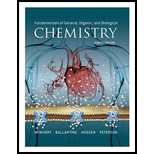
Fundamentals of General, Organic, and Biological Chemistry - With Access
8th Edition
ISBN: 9780134465708
Author: McMurry
Publisher: PEARSON
expand_more
expand_more
format_list_bulleted
Concept explainers
Question
Chapter 29, Problem 29.16AP
Interpretation Introduction
Interpretation:
The effects on solutes crossing cell membranes due to the differences in pressure between arterial capillaries, interstitial fluids and venous capillaries have to be given.
Concept Introduction:
Body fluids: About
Intracellular fluid: The fluid inside the cells.
Extracellular fluid: The fluids outside the cells and it include mainly plasma and interstitial fluid.
Passive diffusion is the movement of solutes which can cross the membrane freely and move from regions of high solute concentration to the region of low solute concentration.
Expert Solution & Answer
Want to see the full answer?
Check out a sample textbook solution
Students have asked these similar questions
Why would it be dangerous to administer intravenous fluids that do not have an osmotic pressure comparable to that of bodily fluids?
How are ions distributed among intercellular, extracellular and plasma compartments?
when a person receive intravenous fluid to help up blood volume , why is it important to for the fluid to be isotonic?
Chapter 29 Solutions
Fundamentals of General, Organic, and Biological Chemistry - With Access
Ch. 29.1 - Prob. 29.1KCPCh. 29.3 - Prob. 29.1CIAPCh. 29.3 - Prob. 29.2CIAPCh. 29.3 - Prob. 29.3CIAPCh. 29.3 - Prob. 29.4CIAPCh. 29.3 - Match each term in the (a)(e) group with its...Ch. 29.5 - Prob. 29.3KCPCh. 29.5 - Prob. 29.4PCh. 29.5 - Prob. 29.5PCh. 29.8 - Prob. 29.5CIAP
Ch. 29.8 - Prob. 29.6CIAPCh. 29.8 - One of the more advanced blood tests used to...Ch. 29 - Body fluids occupy two different compartments,...Ch. 29 - Prob. 29.7UKCCh. 29 - Prob. 29.8UKCCh. 29 - Prob. 29.9UKCCh. 29 - Prob. 29.10UKCCh. 29 - Prob. 29.11UKCCh. 29 - Prob. 29.12UKCCh. 29 - Prob. 29.13APCh. 29 - Prob. 29.14APCh. 29 - Prob. 29.15APCh. 29 - Prob. 29.16APCh. 29 - Prob. 29.17APCh. 29 - Prob. 29.18APCh. 29 - Prob. 29.19APCh. 29 - Prob. 29.20APCh. 29 - Prob. 29.21APCh. 29 - Prob. 29.22APCh. 29 - Prob. 29.23APCh. 29 - What are the three main types of cells found in...Ch. 29 - Prob. 29.25APCh. 29 - Prob. 29.26APCh. 29 - Prob. 29.27APCh. 29 - Prob. 29.28APCh. 29 - Prob. 29.29APCh. 29 - Prob. 29.30APCh. 29 - Prob. 29.31APCh. 29 - Prob. 29.32APCh. 29 - Prob. 29.33APCh. 29 - Prob. 29.34APCh. 29 - Prob. 29.35APCh. 29 - Prob. 29.36APCh. 29 - Prob. 29.37APCh. 29 - Prob. 29.38APCh. 29 - Prob. 29.39APCh. 29 - Prob. 29.40APCh. 29 - Prob. 29.41APCh. 29 - Prob. 29.42APCh. 29 - What color is deoxyhemoglobin? Why?Ch. 29 - Prob. 29.44APCh. 29 - Prob. 29.45APCh. 29 - Prob. 29.46APCh. 29 - Prob. 29.47APCh. 29 - Prob. 29.48APCh. 29 - Prob. 29.49APCh. 29 - Prob. 29.50APCh. 29 - Prob. 29.51APCh. 29 - Prob. 29.52APCh. 29 - Prob. 29.53APCh. 29 - Prob. 29.54APCh. 29 - Prob. 29.55CPCh. 29 - Prob. 29.56CPCh. 29 - Prob. 29.57CPCh. 29 - How does active transport differ from osmosis?Ch. 29 - Prob. 29.59CPCh. 29 - Prob. 29.60CPCh. 29 - Prob. 29.61CPCh. 29 - Prob. 29.62CPCh. 29 - Have each member of your group choose an energy...Ch. 29 - Prob. 29.64GPCh. 29 - Prob. 29.65GP
Knowledge Booster
Learn more about
Need a deep-dive on the concept behind this application? Look no further. Learn more about this topic, biochemistry and related others by exploring similar questions and additional content below.Similar questions
- what happens to cells when the concentrations of nonpenetrating solutes across the cell membrane are changed?arrow_forwardWhat impact would isotonic saline have on the amount of red blood cells present in plasma, and what difference will distilled water make if it is used instead of isotonic saline?arrow_forwardWhat is Diffusion Rate?arrow_forward
arrow_back_ios
SEE MORE QUESTIONS
arrow_forward_ios
Recommended textbooks for you

Phylogenetic Mysteries: Crash Course Zoology #12; Author: CrashCourse;https://www.youtube.com/watch?v=cVaw7nF72Aw;License: Standard youtube license